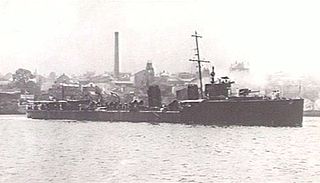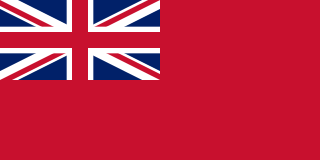Related Research Articles

Launched in 1759, the third Supply was a Royal Navy armed tender that played an important part in the foundation of the Colony of New South Wales. The Navy sold her in 1792. She then served commercially until about 1806.

HMS Indefatigable was one of the Ardent-class 64-gun third-rate ships-of-the-line designed by Sir Thomas Slade in 1761 for the Royal Navy. She was built as a ship-of-the-line, but most of her active service took place after her conversion to a 44-gun razee frigate. She had a long career under several distinguished commanders, serving throughout the French Revolutionary Wars and the Napoleonic Wars. She took some 27 prizes, alone or in company, and the Admiralty authorised the issue of four clasps to the Naval General Service Medal in 1847 to any surviving members of her crews from the respective actions. She was broken up in 1816.

The Hecla class was a class of bomb vessels of the Royal Navy of the early 19th century. They were designed for use as bomb or mortar ships and were very heavily built. Eight ships were launched; all were converted for use as exploration or survey ships. Four ships of the class are known for the role they played in Arctic and Antarctic exploration.

Sir Thomas Slade was an English naval architect best known for designing the Royal Navy warship HMS Victory, which served as Lord Nelson's flagship at the Battle of Trafalgar in 1805.

HMAS Huon (D50), named after the Huon River, was a River-class torpedo-boat destroyer of the Royal Australian Navy (RAN). Originally to be named after the River Derwent, the ship was renamed before her 1914 launch because of a naming conflict with a Royal Navy vessel.
HMS York was a 64-gun third rate ship of the line of the Royal Navy, launched on 24 March 1796. She served briefly in the West Indies where she captured numerous small vessels. She was wrecked in 1804.

The Kingston Royal Naval Dockyard was a Royal Navy Dockyard from 1788 to 1853 in Kingston, Ontario, Canada, at the site of the current Royal Military College of Canada.

Provincial Marine was a coastal protection service in charge of the waters in the Great Lakes, the St. Lawrence River and parts of Lake Champlain under British control. While ships of the Provincial Marine were designated HMS, they were operated in more of a coast guard manner than as a full-fledged navy. Most ships of the Provincial Marine were built on the Great Lakes.
Thomas Moore was an early European settler in Australia.

The State Dockyard was a ship building and maintenance facility operated by the Government of New South Wales in Carrington, Newcastle, New South Wales, Australia between 1942 and 1987.

HMS Monmouth was a 64-gun third rate ship of the line of the Royal Navy, launched on 23 April 1796 at Rotherhithe. She had been designed and laid down for the East India Company, but the Navy purchased her after the start of the French Revolutionary War. She served at the Battle of Camperdown and during the Napoleonic Wars. Hulked in 1815, she was broken up in 1834.
Frindsbury TQ744697 51°23′58″N0°30′29″E is a parish on the River Medway, on the opposite bank to Chatham Dockyard in Kent, England. It was a centre of ship building before 1820, building at least six 74 gun third rate ships of the line and many smaller vessels. From 1820, until recent times, the ship yards built over 100 Thames sailing barges. Shipbuilding has stopped but in 2006, one yard was still active in ship repair.
HMS Eurydice was a 24-gun Porcupine-class post ship of the Royal Navy built in 1781 and broken up in 1834. During her long career she saw service in the American War of Independence, the French Revolutionary Wars and the Napoleonic Wars. She captured a number of enemy privateers and served in the East and West Indies, the Mediterranean and British and American waters.

The Seringapatam-class frigates, were a class of British Royal Navy 46-gun sailing frigates.

Sheerness Dockyard was a Royal Navy Dockyard located on the Sheerness peninsula, at the mouth of the River Medway in Kent. It was opened in the 1660s and closed in 1960.

HMS Salamander was one of the initial steam powered vessels built for the Royal Navy. On 10 January 1831 the First Sea Lord gave orders that four paddle vessels be built to competitive designs. The vessels were to be powered by Maudslay, Son & Field steam engines, carry a schooner rig and mount one or two 10-inch shell guns. Initially classed simply as a steam vessel (SV), she was re-classed as a second-class steam sloop when that categorization was introduced on 31 May 1844. Designed by Joseph Seaton, the Master Shipwright of Sheerness, she was initially slated to be built in Portsmouth, and was changed to Sheerness Dockyard. She was launched and completed in 1832, took part in the Second Anglo-Burmese War and was broken up in 1883.
Five vessels of the Royal Navy have been named HMS Harlequin.
Francis was a 41 tons (bm) colonial schooner that was partially constructed at the Deptford Dockyard, England, and sent in frame aboard the Pitt to Australia to be put together for the purposes of exploration. The vessel had originally been designed for George Vancouver’s discovery voyage of the west coast of North America.
Several vessels have been named Recovery:
References
- Russell, Eric (1975). Thomas Moore and the King's dock yard. Somersby NSW: Old Sydney Town. ISBN 978-0-86900-024-3.
- End of Argyle Street - Historical land viewer - St Philip 33°51′34″S151°12′35″E / 33.859573°S 151.209782°E